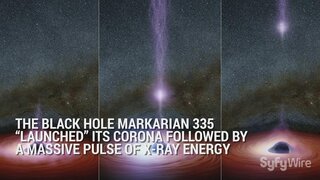Has Hawking Radiation Ever Been Observed?
Not yet, but it could be soon!
While the crew of SYFY’s The Ark (now streaming on Peacock!) is bravely pushing the boundaries of human exploration, those of us in the real world are restricted to a thin sphere of space on and around our own planet. Exploring the cosmos is mostly a matter of remote observation and math, but that’s gotten us pretty far. Math hinted at the existence of monster black holes and, eventually, observation confirmed them.
The popular image of black holes is one of bottomless pits, endlessly hungry singularities gobbling up anything unfortunate enough to cross beyond their event horizons. So strong is their gravitational influence that nothing, not even light, can escape their grasp. That image is fairly accurate, but math has revealed it to be incomplete. In 1974, Stephen Hawking suggested that black holes may not be the one-way oblivion pits they seem to be. Instead, he suggested that black holes should emit particles, popularly known as Hawking radiation.
Over time, this escaping radiation eats away at the black hole, shrinking its mass and the diameter of its event horizon. On long enough time scales, Hawking radiation should cause even the largest black holes to evaporate. To date, Hawking radiation remains theoretical, never having been directly observed, but a recent study posted to the preprint server arXiv suggests we should be able to detect it with existing telescopes.
For More on Black Holes:
NASA's Black Hole Visualizations Show What It Might Look Like to Fall into a Black Hole
It's Not the Closest Black Hole to Earth, But the Biggest Stellar Mass Black Hole Ever Found Ain't Far
How Worried Should We Be About Black Holes? Separating Fact from Fiction
It Might Be Possible to Detect Hawking Radiation from Earth
According to Hawking’s equations, the temperature of radiation seeping out of a black hole’s event horizon is inversely proportional to the mass of that black hole. Put simply, the smaller a black hole, the hotter and faster it burns. An unfortunate consequence for astronomers is that the most obvious targets, the supermassive black holes at the centers of galaxies, are radiating too coolly for modern telescopes to detect. The new paper outlines a black hole loophole allowing astronomers to detect Hawking radiation under the right circumstances.
The process relies on a number of physical phenomena working in concert to produce a brief window of detectability. When a black hole collides with a high mass object (another black hole or a neutron star) it produces gravitational waves which shake the fabric of spacetime. The first confirmed detection of gravitational waves occurred at the LIGO observatory in 2015, following the merger of two black holes. As massive objects grow nearer, they orbit one another in a tightening spiral, violently warping spacetime and emitting “black hole morsels,” tiny black holes the mass of an asteroid.
Taken together, researchers found that black hole morsels produced during high mass mergers should be light enough to emit Hawking radiation detectable by sensitive telescopes. Detecting them relies on another physical phenomenon known as Cherenkov radiation. While light moves at a fixed rate in a vacuum, its rate of travel changes depending on the medium. Light travels more slowly through water than through air, for instance, as seen anytime you drop a straw in a glass of water and notice the light bend. Nothing can travel faster than the speed of light in a vacuum, but it is possible to travel faster than the speed of light in a particular medium. When that happens, you get Cherenkov radiation, a visual analogue to the sonic boom heard when an object breaks the sound barrier.
When high-energy photons from black hole morsels enter the Earth’s atmosphere, they’re traveling faster than the ordinary wave velocity of light in air, producing flashes of Cherenkov radiation. There are four telescopes around the world – the High energy Stereoscopic System (HESS), the Major Atmospheric Gamma Imaging Cherenkov Telescope (MAGIC), the First G-APD Cherenkov Telescope (FACT), and the Very Energetic Radiation Imaging Telescope Array System (VERITAS) – which should be capable of detecting atmospheric Cherenkov flashes from black hole morsels. Now we just need to find a black hole merger in progress, point our Cherenkov telescopes at it, and see what we can see.
Want to see more of the universe, catch The Ark! Season 2 premieres on SYFY beginning Wednesday, July 17 at 10/9c. Catch up on the entirety of Season 1, streaming now on Peacock!
















































